The Gurs camp was located in the rural community of Gurs in the Basses-Pyrénées department, 40 kilometres west of Pau, France. It was set up by the French government in April 1939, initially for Spanish refugees and fighters fleeing the Spanish Civil War. Before the outbreak of World War II in September 1939, just over 27,000 people were interned there, 40 per cent of whom were gradually released or repatriated. Subsequently, between September 1939 and July 1940, almost 15,000 people were also interned as foreign nationals (Spaniards, Germans or Austrians), considered at the time by the French authorities to be ‘undesirable persons’.
Under the Vichy regime, which took power in September 1940, more than 18,000 people were interned in Gurs between October 1940 and November 1943. A large proportion of them were Jews of German, Austrian and Polish origin, of whom nearly 4,000 were eventually deported to the East, mainly to Auschwitz-Birkenau concentration and extermination camp.
It is not well known that the Gurs camp also played a role in the persecution of Roma, Sinti (Manouches) and Kale (Gitans): From summer of 1940 to the summer of 1944, an estimated 200 to 300 Romani people were interned or imprisoned there.
The Camp
The camp occupied a rectangular area two kilometres long and 400 metres wide and was divided into 13 ‘islets’ (îlots) designated by letters from A to M. The whole camp was divided into two parts separated by a central tarmac road. Each îlot was separated from the others by barbed wire and a guarded gate, and the entire camp was surrounded by a second line of barbed wire. Separate îlots were set aside for women and young children.
In October 1940, the camp consisted of 428 barracks, 382 of which were for internees, and had a capacity of 19,000 people: the internees’ barracks, built on the model of ‘Adrian-type’ French military barracks, were rudimentary and exposed the internees to cold, damp, darkness and overcrowding. Under the collaborating Vichy regime, the camp was administered by several senior police officers under the authority of the Prefect of the Basses-Pyrénées. The heads of the camp were in charge of the facilities management services, around fifty police officers and several dozen guards.
Romani Refugees
During the summer of 1940, the Gurs camp became a camp for refugees fleeing Nazi persecution. Starting in May 1940, several hundred Roma, mainly from the Paris region, had fled to the south of France in the hope of crossing the border into Spain. Around a hundred Roma who had managed to enter Spain were nevertheless sent back to France when German troops reached the border town Hendaye on 27 June 1940.
Those affected, mainly families with children, were first placed in a centre for refugees in Orthez and then moved to the Gurs camp, which was east of the demarcation line between German-occupied and Vichy France that had been established on 25 June, and thus on unoccupied French territory.
Matéo Maximoff (1917–1999), who was among those transferred to Gurs, later recounts in particular the period between the end of June and the beginning of August 1940, during which the families had been separated into different îlots of the camp: those for men and those for women and small children. The separation of the families provoked a great deal of resistance from the Romani internee groups. Additionally, the camp administration decided to separate the Roma refugees from the rest of the internees and place them in separate barracks.
During this period, they suffered ostracism from other internees and chronic malnutrition. Some men were subjected to forced labour and chopped wood for heating. Some were allowed to walk to Orthez to get medicines from a pharmacy. Some took part in an orchestra formed for the officers’ celebrations on 14 July, Bastille Day (the French national holiday).
French writer and film critic Léon Moussinac (1890–1964), who had been interned for ‘communist propaganda’, mentioned the presence of Roma internees at Gurs in his memoirs. The Franco-German artist and painter Lou Albert-Lasard (1895–1969), interned in Gurs in summer 1940, produced a series of drawings of Roma women and children interned in the same îlot as the German and Austrian women.
After six weeks’ internment, the approximately one hundred Romani men, women and children were moved to Tarbes on 9 August 1940 and then interned, for the most part, in the Lannemezan detention camp from spring 1941 until the end of the war.
Internment of ‘Nomades’
From the summer of 1940, the Gurs camp also became a place of internment for people designated as ‘Nomades’ in France, subject to the decree on enforced residence (house arrest) of 6 April 1940 and the internment order of 4 October 1940. Between July 1940 and the administrative dissolution of the camp on 1 November 1943, this affected several dozen people. These were showmen [forains], travelling salesmen [marchands ambulants] or ‘Nomades’ arrested by the gendarmerie or previously held in prisons. Their internment at Gurs was temporary, and they were then redirected to other camps or to neighbouring towns where they were placed under house arrest.
Several dozen Sinti (Manouches) evacuated from Alsace to the south of France from autumn 1939 onwards were also interned at Gurs during this period. Their family members were held in the camps of Rivesaltes, Argelès, Le Barcarès or Noé, and some had escaped from these camps, only to be re-arrested and temporarily interned in Gurs. In April 1941, the camp administration also counted around ten ‘Nomades’ internees.
Between the summer of 1941 and the winter of 1942/43, several dozen ‘Nomades’ were again interned in the Gurs camp. Their internment, which was also temporary, followed a directive in October 1941 to redistribute internees according to the category to which they belonged in the eyes of the authorities (Jews, resistance fighters and ‘Nomades’), in both the occupied and unoccupied zones. ‘Nomades’ internees passed through Gurs on their way to or from camps such as Noé, Fort-Barraux, Brens and Nexon. After the creation of the Saliers camp in March 1942, the Gurs camp also became a departure point for transfers to Saliers and was used as a punishment camp for groups or individuals who had escaped from Saliers or for groups deemed by the authorities to be resistant to the house arrest regime.
Spring 1944
From spring 1944, with the approach of the Allied troops and following orders to evacuate the coastal areas of southern France, the Gurs camp once again became a camp for so-called Nomades. Some groups, considered by the administration of the Saliers camp to be the most resistant to internment, were transferred to Gurs.
Many municipalities in south-west France also took advantage of this situation to request the imprisonment of Romani groups who were already in enforced residence in their jurisdiction. A ‘district reserved for Nomades’ was set up in îlot J.
By the end of June 1944, 55 people had been imprisoned as ‘Nomades’ in the Gurs camp. As the war drew to a close, some groups managed to escape, sometimes with the help of the maquis. The last ‘Nomades’ were released in October 1944, but some of them were then placed under house arrest.
Outlook
The significance of the Gurs camp for the persecution of people designated as ‘Nomades’ in France and Europe has been underestimated until now. Gurs was an important transit camp, serving as a temporary place of internment for hundreds of Roma, Sinti (Manouches) and Kale (Gitans), from where the Vichy authorities controlled their transfer to detention camps, particularly to or from Saliers.
However, the Gurs camp also served as a site of repression to punish ‘Nomades’ who had escaped or resisted internment in camps or enforced residence. The total number of ‘Nomades’ interned or imprisoned in Gurs can currently only be estimated at up to 300 people.
Aftermath
On 30 August 1944, the Résistance movement took control of the camp. A minimal administration remained in place until January 1945. In 1946, the camp structures and all the barracks were completely dismantled. Starting in 1957, the cemetery was redeveloped, and it reopened in 1963. Several steles have been erected in memory of the victims.
Remembrance ceremonies were organised regularly from 1979 onwards, but the presence of Roma and Sinti in the Gurs camp was not recognised until recently. On 23 October 2011, twenty-seven columns were erected along an alley of remembrance in memory of all the communities of internees. Since then, one column honours ‘126 Gitans (Gitanos) French, Romanian and Bulgarian’. The origin of this figure and the reason for mentioning these nationalities is not known.




